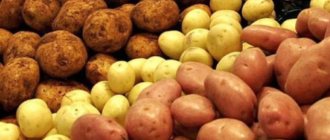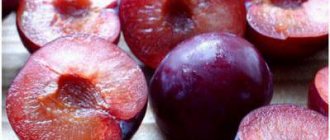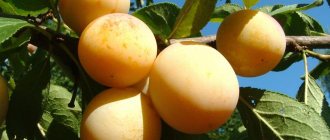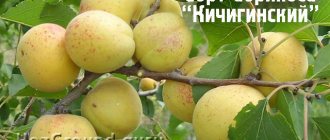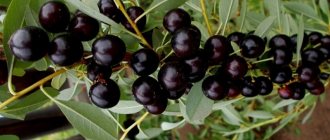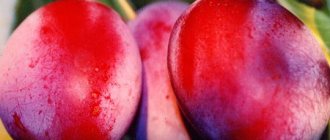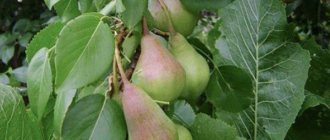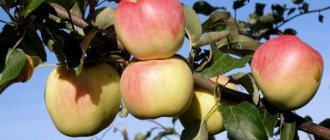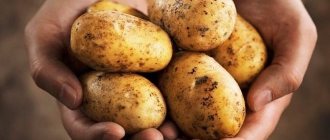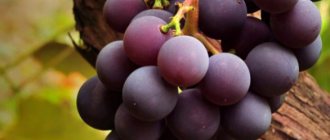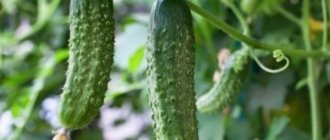Types of plums for Siberia
For the Siberian climate, three varieties have traditionally been identified:
- Chinese variety (Ussuri plum);
- hybrids obtained from crossing American and Canadian varieties (Karzinskaya);
- plum-cherry hybrids (least common because the harvest they bring is inconsistent).
A hybrid of Ussuri plum crossed with cherry plum has become more widespread in Siberia. Received the name “Russian plum”.
Plum for Siberia - early varieties
The advantages of this plum:
- flowers are able to withstand temperatures down to -3 degrees below 0;
- fruiting in the third - fourth year;
Disadvantages:
- self-sterility (for fruit to set, at least three mutually pollinating varieties are required in the garden);
- even a slight excess of moisture negatively affects the condition of the plant;
- the roots are located almost on the surface.
Karzin plums are less common because the fabrics are susceptible to damping in winter.
A very important indicator is disease resistance, and if the trees are already sick, then you will find an article about the treatment of plum moniliosis with folk remedies and medications useful.
Plum-cherry hybrids are represented by bushes with a height of 2 to 3.5 meters, and a diameter of up to 3 meters. Flowering is later and lasts no more than 10 days. Winter hardiness is low. This is associated with inconsistency in fruiting. But they begin to bear fruit earlier. The first fruits appear already in the second year after planting.
The best plum varieties for the Moscow region
Care
Caring for plums in Siberia depends on the specific area and microclimate. The harsher the region, the less pruning, organic fertilizing and watering should be done.
In the Novosibirsk, Tomsk and Irkutsk regions, in Buryatia, there is no need to further injure and stimulate the plants.
Formation
Scheme for pruning plum trees in the first years of life.
For Siberian plums, it is desirable to maintain the genetically determined head start of the variety - a tree or bush. The trees are formed on a low trunk, cutting the seedling by a third when planting.
- If a root shoot appears, it is cut out . Side shoots are left only on self-rooted plums if they are needed to renew dead trunks and aging specimens.
- Sanitary pruning is performed in the spring, removing dry, broken, frozen branches. Frostbites are stripped down to healthy tissue. The wounds are immediately covered with varnish .
- Experienced gardeners do not advise shortening healthy annual growth : this is where the future harvest is laid.
- In aging trees (sometimes as early as 7–8 years old ), young shoots grow weakly and large branches die off. Early spring anti-aging pruning is required for 3-5 year old wood (removing up to 30% of the crown, but no more). Plums in Siberia can grow and bear fruit for 10–20 years. There are known “long-livers” whose age is 60–80 years .
Whitewash
The trunks and skeletal branches protect against winter-spring sunburn with the help of whitewash.
The work is carried out in the fall, using a mixture: 3 kg of lime, 2 kg of clay, 500 g of iron sulfate (diluted with water to the desired consistency).
Prevention of damping off
When damping occurs, the bark and cadmium at the base of the trunk die off.
Particularly dangerous for plums is this type of winter damage, such as partial heating and complete damping off - death of the bark and cambium in the lower part of the trunk and on the root collar. The pathology develops when in the fall the snow cover falls on the unfrozen ground, and in the winter loose snowdrifts of more than 40 cm grow. The base of the tree rots in dampness, at temperatures around zero.
Sometimes damaged plants begin to bloom in the spring, but then gradually wither or die completely. Often shoots appear from the root, but this too can support the plant in subsequent years.
It is damping off, and not freezing, that is the main cause of death of plum plants in Siberia (if we are talking about winter-hardy varieties). They have been trying to solve the problem for several decades, breeding new hybrids and selecting rootstocks, but so far there has been no dramatic success. Agrotechnical techniques help out.
Plums planted on a mound rather than in a hole are much less susceptible to damping off.
If plums are planted in a place where the potential height of snow cover is more than 40 cm , it is advisable to ensure that the trunk is free of moisture, as well as the necessary freezing of the ground in the root collar . Various methods are used for this:
- In autumn, with the arrival of cold weather, the tree is covered with large stones.
- The trunk is insulated from the snow by tying dense fabric (like polypropylene sugar bags) in its upper part with a downward expansion in the form of a hut (skirt).
- Trees are protected for the winter with a high casing made of wood, slate or metal, retreating from the trunk 25 cm. The structure is covered from above (to prevent snow from getting inside), providing the base with plums " dry» wintering.
Protecting a young plum seedling from damping off using boards.
- Before snowfalls, a tall barrel is placed upside down near the trunk. In winter, it rises above the snow, and the ground beneath it freezes.
- The snow around the trunk is regularly trampled down , and in March (with the arrival of thaws) it is shoveled away .
Moderate (about 30 cm ) soil freezing is not dangerous for winter-hardy varieties.
Yellow Khopty
This is one of the oldest varieties. An excellent winter-hardy plum variety for Siberia. The tree grows tall. The crown is weakly leafy. Bears fruit intermittently.
Photo of plum variety Yellow Khopty:
Plums are yellow in color and round in shape. The weight of one fruit of the “Yellow Khopty” variety is up to 15 g
. The taste is sweet and sour with the presence of bitterness. The yield is up to 12 kg per plant. The fruits ripen at the end of August. The fruits spoil quickly.
Pride of the Urals
This variety was bred in the Urals. This is a frost-resistant plum variety that can take root and bear fruit in Siberia.
. Excellent resistance to frost. It doesn't fade, which is a big plus.
Among the disadvantages: after a thaw, fruit buds may freeze slightly. But it brings a harvest every year. Plums 20 g each
. The average yield is 10 kg per plant. The skin is burgundy. The taste is sweet.
How to properly prepare a plant for winter
As a rule, you need to prepare for winter 1-2 weeks before the onset of cold weather. Organic fertilizers are added to the tree trunk circle: mix 1 bucket of humus, 40 g of potassium sulfate and 250 g of wood ash. Fertilizer is applied to previously loosened soil, lightly digging in with a hoe or shovel. Finally, water the ground with 2-3 buckets of water.
After this, it is important to inspect the trunk and crown for the presence of dry branches. Damaged bark can be removed using a scraper or wire brush. When performing work, you should be careful not to damage healthy areas of the tree.
To protect against insects, the trunk is treated with a special solution, which can be purchased at the store or made independently. To do this, you will need to mix in equal proportions: clay, lime and mullein. If desired, you can add copper sulfate - 25 g per 1 liter of solution.
Before frost, the tree trunk circle is insulated with straw or burlap. If a severe winter is expected, cover the ground with slate or roofing felt. If the plant is still small, you can make a “hut” from scrap materials.
Note! Strong gusts of wind can cause the cover to fly away, damaging the plants. It is recommended to secure the structure by driving several pegs into the ground and tying the shelter to them.
For those who decide to plant fruit and berry crops in Siberia, be sure to read the description of the selected variety. All you need for proper planting is a little patience and time to study the technology. And after 4 years the plum will delight you with its sweet fruits.
Altai anniversary
A good plum variety for growing in Siberia
, despite the fact that frost resistance is assessed as average. The tree grows tall. Orange-red plums ripen by early autumn.
Photo of the Altai Yubileiny plum variety:
Fruit weight from 12 to 18 grams
. Some specimens are larger, up to 35 g. The average yield is up to 12 kg per tree. With good care, the yield can be significantly higher - up to 40 kg.
Growing
Remember that the entire success of planting, further cultivation and obtaining a good harvest directly depends on the choice of place for planting, proper planting and further care of the plant.
Requirements for soil and planting site
First you need to choose a suitable landing site. Follow the recommendations:
- It is worth considering that this plant is capricious and very finicky. It will bear fruit only in areas with good protection from the wind.
- The most suitable option would be gentle slopes on the south, southwest and west sides.
- It is advisable to plant seedlings in well-warmed areas, in places where there is good aeration.
- If you decide to choose a low-lying place for planting plums, then it is advisable to make a small artificial mound there. The height of the hills should be about 40-50 cm, and the size of the base should be almost 2 meters.
- The composition of the soil should also be taken into account. Remember that plum loves soil of gray forest, loamy and chernozem types. In addition, they must have a good level of moisture and breathability.
Landing
Preparing the planting hole
It is best to plant in the spring. Since the climate in Siberia and the Urals is cool, seedlings planted in the fall may not have time to take root and will simply freeze. The optimal period for planting is the third ten days of April.
It is also worth paying attention to the soil, it should thaw and warm up well. The holes should be prepared at the beginning of spring, approximately 2-3 weeks before planting.
The depth of the hole should be almost 60 cm, the diameter should be about 60-70 cm. It is advisable to remove the soil from it and mix it with humus in a ratio of 2 to 1. In addition, you can also pour some complex fertilizers there. After this, the earth is poured back into the hole.
Just before planting, the hole is dug again and the soil is thoroughly fluffed up. Then the seedling must be placed in a hole, with the root collar located 5-6 cm above the surface of the earth, and sprinkled with a small amount of earth. At first, the seedling should be tied to a special wooden peg until the root system is completely strengthened.
Care
Pruning plum
The rules for caring for plums are as follows:
- As soon as the seedling is planted, it must be watered abundantly. Approximately one seedling will require about 30 liters of water. Then it needs to be mulched generously. In the subsequent season, the plum is watered about 3-4 times. The first watering is carried out in mid-May, the second - after the end of flowering during the intensive development of fruits, the third - during the ripening period, the fourth - in late autumn.
- It is also worth paying great attention to feeding. It is necessary to start feeding trees with fertilizers in the third year of their life. For fertilizer, a mixture of humus or compost (about 7 kilograms) and 200 grams of wood ash per 1 square meter is perfect. meter of land. During the active growing season, complex mineral fertilizers should be applied. Nitrogen mixtures should be added in the form of solutions. It is advisable to add phosphorus, potassium, mixtures that have a dry and poorly soluble structure to the soil in the fall.
- Pruning of plum trees should be done in spring, when active sap flow has not yet begun. The process should begin at the seedling stage. Young seedlings begin to actively grow branches and therefore during this period it is possible to form the correct shape of the plum crown. Also, taking into account the feedback from experienced gardeners, it is recommended to remove shoots that are actively growing from the root system. It can affect the further growth and yield of plums.
- In the spring, the trunks should be whitened, this will protect against damage from all kinds of pests. You can also install rodent and mouse protection nearby.
If you decide to plant a plum on your plot, be sure to familiarize yourself with all the varieties intended for cultivation in this region. Also pay attention to the climate: many varieties are very capricious and may not grow well in areas with cold and harsh climates.
Be sure to follow the rules for planting and caring for plum trees. Its further growth and harvest will depend on this. I wish you success!
Watch overview videos about growing plums in Siberia and the Urals:
Rate this article:
(1 vote, average: 5 out of 5)
The plum has always been considered the most whimsical tree for the garden. But today many varieties have been bred that make it possible to successfully grow it even in the coldest corners of the country.
Let's take a closer look at the most popular new products and old proven varieties of the best plums.
Red-cheeked
Another Altai variety of yellow plum for Siberia. The trees grow a little more than 2 meters. They begin to bear fruit in the 4th year. It has increased resistance to frost. And the harvest ripens periodically, every other year.
The weight of one fruit is 13 grams. The shape is spherical. The main taste is sweet and sour, and there is a little bitterness in the skin. Ripe fruits must be collected on time, otherwise the ripened plums will fall off and the harvest may be lost.
In memory of Putov
A tree of medium height with a spherical shape. The height of an adult tree is 2.2 meters. Fruits every year, starting at the age of 4 years.
The fruits are of medium size. Weight – 15 g. The fruits are covered with a dark red skin with a blue coating. The taste is sweet and sour.
Interesting article:
The most delicious varieties of strawberries for Siberia
To get a tasty plum harvest in Siberia, you need to choose the right variety for cultivation.
Climatic characteristics of the region
When growing a plant in Siberia, you can encounter many problems. All of them are associated with the harsh climatic conditions that characterize this region. It is especially difficult to grow plums in the Kemerovo, Tomsk, and Novosibirsk regions. It is best to plant the crop in the Omsk region or Altai. These regions experience fairly warm summers.
The key danger to the plant is the sharp temperature fluctuations that are characteristic of this region. Every year in Siberia there is a sudden cold snap after a short thaw. Most often this happens at the end of winter.
Another common problem that is typical for this region is damping off of culture tissues. In this case, the bark in the area near the base of the trunk or strong skeletal branches suffers. The cause of the problems is prolonged temperatures of 0 degrees amid an abundance of snow.
The best plum varieties for Siberia: reviews from gardeners
Valeria, Omsk region
Plum "Hungarian" is suitable for beginner gardeners.
Easy to care for. Only it requires a sufficient amount of space on the site, because an adult tree reaches 6 meters. The first fruits appeared in the 5th year after planting. Victor Vladimirovich, Irkutsk
The plum variety “Skoroplodnaya” is excellent for the climate of Siberia.
The first harvest is produced in the 2nd year. This is very early compared to other varieties. The early fruiting period is one of the reasons why I chose this variety. The harvest from one adult tree is 25 kg, which is not bad at all. The only drawback is self-sterility. Maria, Kansk
Altai Yubileiny grows beautifully in our area. The harvest can be harvested as early as early September. The fruits have a color unusual for plums – yellow-red. The average weight of a plum is 25 grams. The taste is fruity and sweet.
Features of care
Caring for seedlings consists of watering, seasonal pruning, fertilizing and forming a tree trunk circle. To care for seedlings, in the spring it is enough to carry out formative pruning, which is carried out before the buds swell. After planting, the trunk is shortened to 90 cm in height. Every year (before reaching 4 years of age) in the spring, all skeletal branches are pruned by 10 cm, forming a medium-thickened crown.
It is necessary to regularly water the seedlings and loosen the tree trunk. Liquid is added 4 times a season.
Caring for plums aged 4 years and older consists of:
- establishing supports for fruitful branches;
- mulching the area near the trunk with sawdust (after watering);
- removal of root shoots;
- removing weeds.
